In this Article
Attending a retreat is a mix of learning from your favorite creator in person, meeting other creators just like you, and the rush of accomplishing a mountain of progress in a wildly short amount of time.
For the attendee, a retreat creates change and builds bonds that are hard to replicate in any other way.
As a creator, you’re the reason that happens for someone else.
Planning a retreat can feel like a huge endeavor, but it will increase your income and cement your relationship with your most loyal customers.
And with this guide, it won’t be overwhelming at all—we promise.
What is a retreat, and who can host them?
A retreat is an event in which a group of people get together in a designated location to learn, bond, and work on self-improvement around a specific topic and goal.
For attendees, the aim is to get away from everyday responsibilities and make progress in a specific area of their lives. For example, finances, fitness, or career.
For the host, a retreat is a chance to give full attention to a small portion of their audience and serve them in a more customized and intimate way. Which helps foster deeper connections.
Any type of creator, from bloggers and YouTubers to coaches and artists, can host a retreat.
If people subscribe to your emails and pay for your products or services to learn from you, figure out a retreat topic they’d love.
Here are some ideas to get you started:
- Wellness and fitness instructors: meditation retreat, yoga retreat, retreat focused on fitness or nutrition education, workshops, and classes
- Service providers, coaches, and consultants: business strategy retreat, financial planning and independence retreat, coworking retreat
- Authors and writers: writing retreat, book publishing retreat, editing workshops
- Bloggers, YouTubers, and influencers: content marketing retreat, YouTube growth retreat, retreat for building partnerships and winning sponsorships
The positive impacts of hosting a retreat
Every new launch you run as a creator has the chance to change your business and life for good. When it comes to retreats, they can become your biggest money-maker—their size and scale make the potential impact all the more monumental.
Here’s how and why:
- Add a high-ticket offer to your portfolio: Let’s say you’re currently selling ebooks and online courses ranging from $50 to $200. In-person retreats can have four-figure price tags, which can help you attract audience members looking for a more hands-on approach and position yourself as an authority.
- Diversify and increase your income: Selling one $1,500 retreat ticket replaces 30 sales of a $50 ebook. With a retreat in your product portfolio, you can likely run fewer launches, still increase your income, and prevent burnout.
- Identify your premium clients: Once you start selling your retreat, you’ll notice people in your audience who are willing to pay a lot more to get the best, most customized teaching from you. Tag and track them in your email marketing system and give them special attention and offers in upcoming launches.
- Gain invaluable customer insights: Retreats let you put faces on your audience members and their problems. They’re a customer research mechanism, letting you explore what they’re struggling with and get fresh ideas for new content and products.
7 tips for planning a memorable in-person retreat
The best retreat is transformative, memorable, and profitable. When you hit all those notes, attendees will want to return, and they’ll passionately recommend it to others.
But for first-time retreat planners, putting together the perfect package can be daunting.
Is this too expensive to consider?
Am I even qualified to talk to people for a whole weekend, ensuring it’s a worthwhile use of their money?
Will I lose money because the venue, food, and speaker costs are too high?
If people even come, will they leave disappointed because they didn’t get the results they wanted?
Here’s the good news: with some dedicated retreat planning, you’ll run the retreat of your (and your attendees’) dreams.
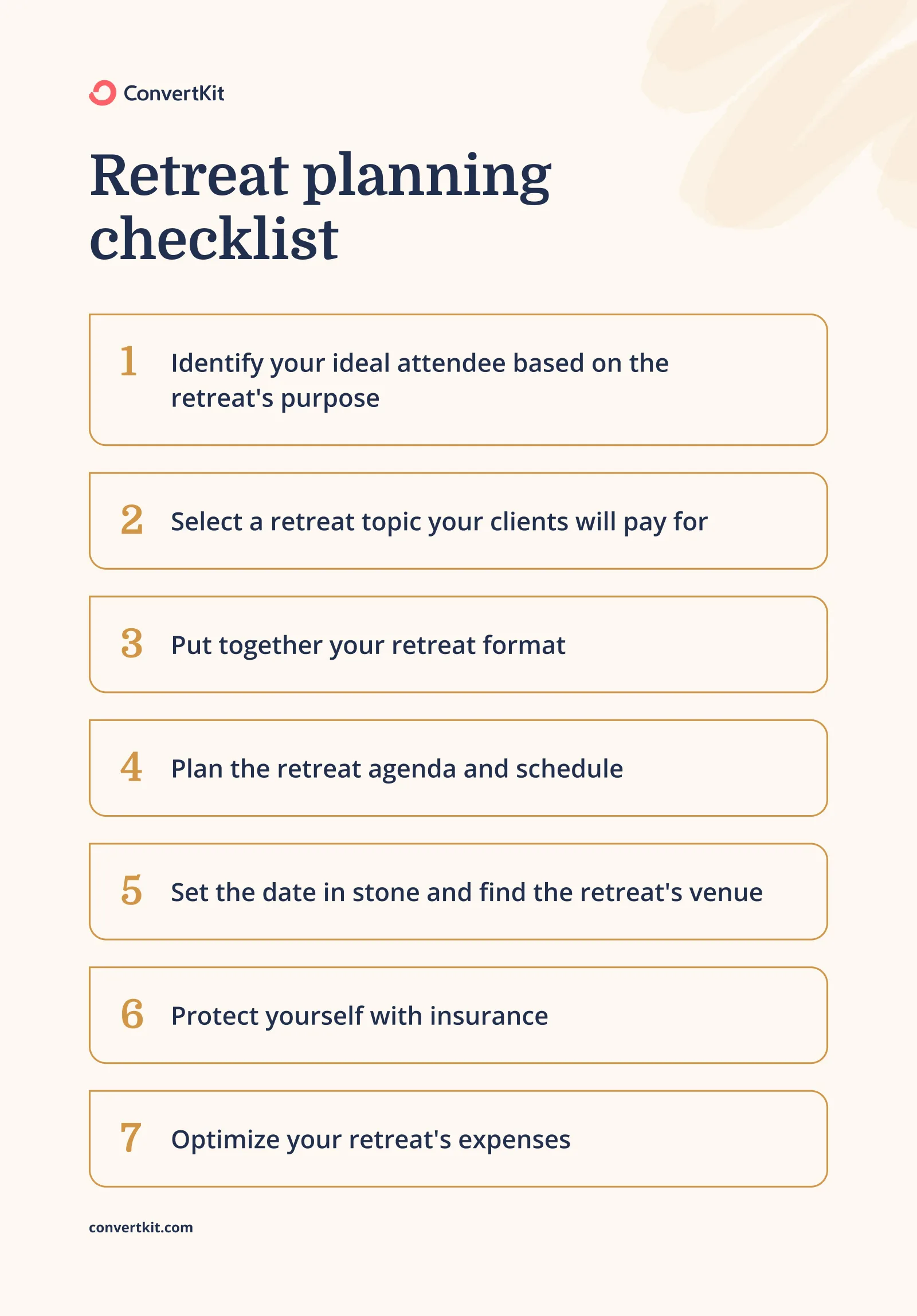
1. Identify your ideal attendee based on the retreat’s purpose
Think about the type of leadership and support you want to provide as the retreat organizer. To do that, consider whether you want to:
- Provide a premium experience for your high-spend customers?
- Offer a concentrated burst of action items and accountability to those who want to tackle their issues quickly?
- Simply give customers the opportunity for face time with you and others in a similar position to theirs?
This will drive the type and structure of your retreat—and with it, your ideal retreat attendee.
For example, if your creative business focuses on coaching writers, a retreat for first-time authors who want to publish a book will be quite different to the one for writers who want to learn to solve their creative block.
Define who you want to serve with your retreat, in what way, and with what energy—it will drive the next steps of your retreat planning (and later, retreat marketing).
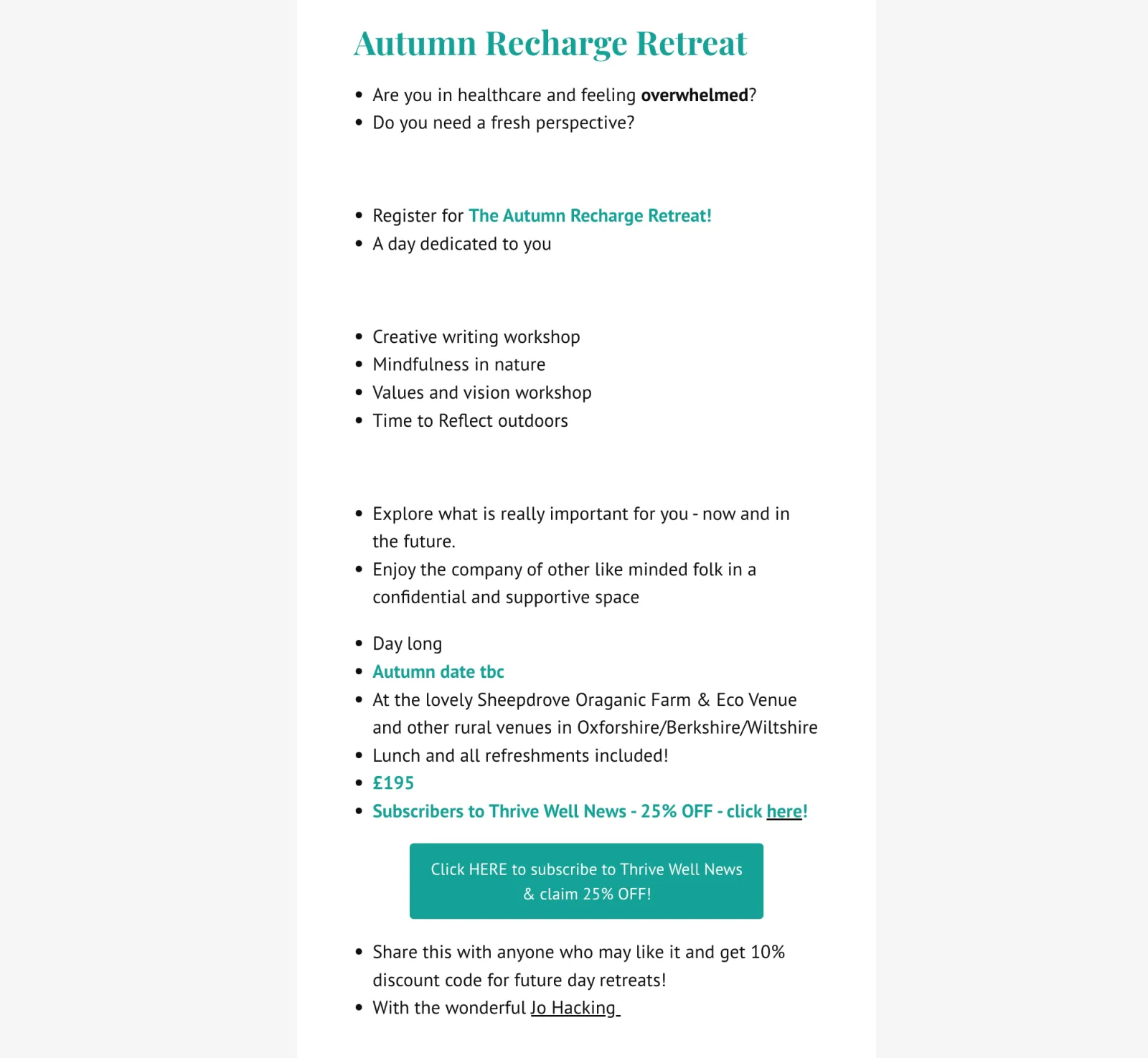
Example of a clearly defined retreat attendee—an overwhelmed healthcare worker. Image via Working Well Doctor.
2. Select a retreat topic your clients will pay for
The perfect retreat topic guarantees satisfaction for your attendees. There are two sides to that coin:
- Making people confident about your retreat upfront, so they book
- Making attendees feel the same way at the end, so they keep buying from you and also tell others about it
The way to make this happen? By promising a clear deliverable.
You might see retreats and intimate conferences—even leaders in their industries—get this wrong and scramble to fill seats. They run five concurrent conference tracks to cover “everything going on in the industry you can’t afford to miss.”
But, that approach can overwhelm potential attendees because it lacks clarity.
Skip that mistake and go for a goal that’s achievable in a weekend or a week—something that will leave those who attend tangibly better. For example:
- “Go from a podcast idea to a live, launched podcast in a week”
- “You’ll leave with a complete fitness and nutrition plan to hit your goals”
- “Rest, reflect, and set goals for the next year in one weekend”
If you’re torn between multiple topics or want to find a specific topic angle to focus on, your best bet is surveying your audience. They want you to help them—a survey will reveal their burning questions and tough challenges.
When putting a price on your retreat, remember you can include the cost of accommodation and meals in your fee or have the attendees cover those themselves. It tends to go better when everything is included, but the choice is ultimately yours.
And with that in mind… Don’t undercharge.
You might be tempted to just add a small margin on top of the costs of organizing, but remember you’re also charging for your skillset, time, focus, and long-term results you provide.
Low cost can feel like low value to those who need what you sell, so go into this process confidently.
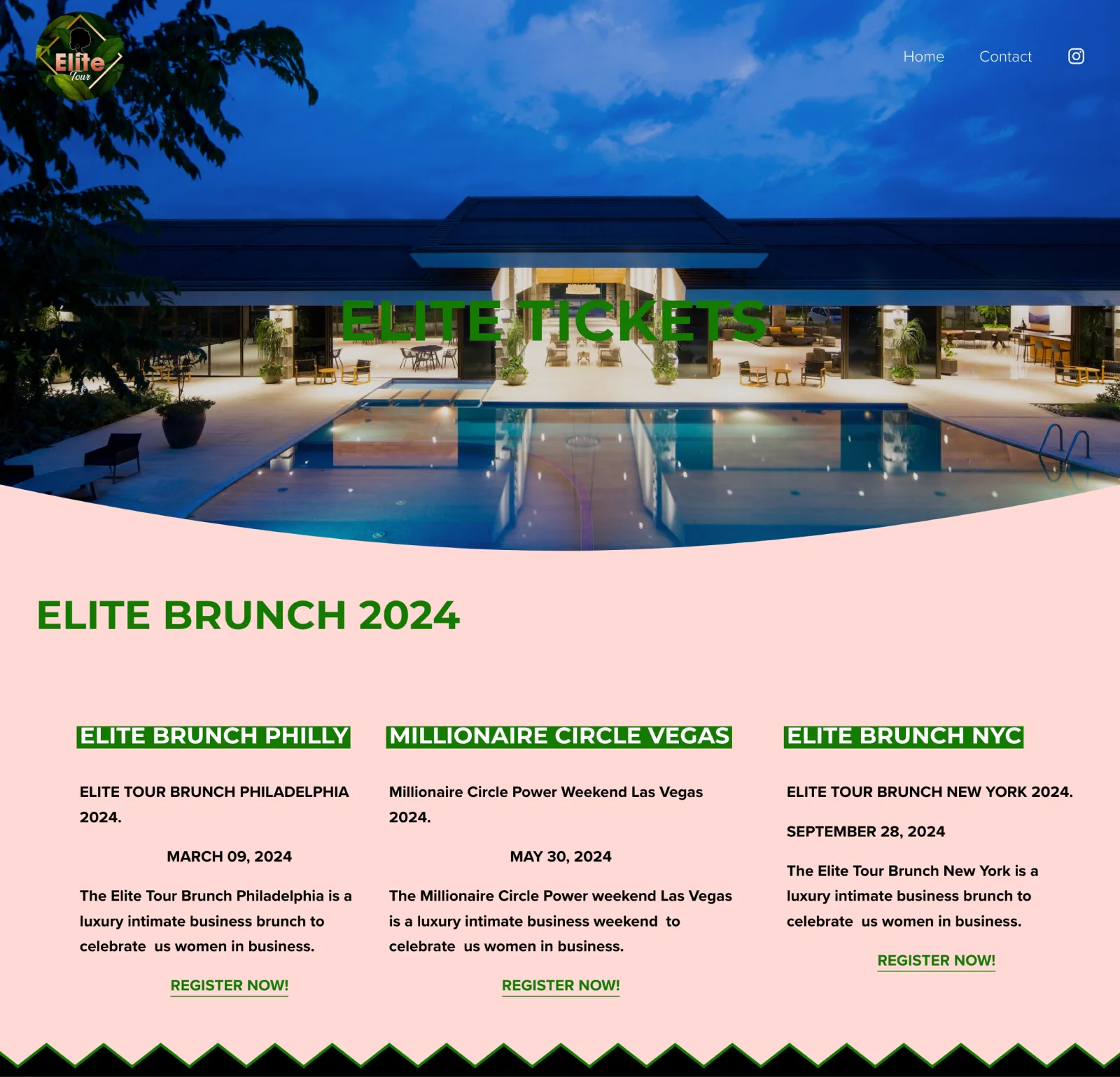
A range of options for women entrepreneur retreats, from $200 to $1,500. Image via Elite Tour.
3. Put together your retreat format
Next up is choosing your retreat structure, including the number of participants, length, location, and name.
Remember that running a retreat is stressful, including the lead-up, the sales process, and the event itself. The best thing you can do is start with something that feels completely comfortable and doable.
Number of retreat participants
Your retreat can be as small as five to seven people and as big as 30-40 attendees. Different retreat purposes and goals will require different levels of hands-on involvement with attendees.
How many people are you comfortable having at your retreat, tending to, and being responsible for the satisfaction of? The smaller the group, the easier to check in with everyone and tailor their experience.
Retreat length
Retreats start at a minimum of two days; longer ones span from seven to nine days. A three-day retreat is the simplest, most flexible starting point—it’s easy to fit into a work week and the right length to fit a decent amount of content into.
You can work up to longer retreats as you get more experience running them.
Retreat location
Have you envisioned your event in a completely private space, like a vacation home rental, or something more public, like a hotel meeting room or even a coworking space?
Consider venues you don’t have to travel far to and those that make food and lodging easy to access. That removes the distraction of daily commutes and gets everyone focused on the reason they’re at the retreat in the first place.
Retreat name
Name your retreat something that will be easy to understand and remember. Don’t overthink it. You can go as simple and obvious as “Fiction Writing Retreat” or with something more creative, like “Unskippable Books Retreat.”
Starting simple means you can move on to the next step faster, and you can always evolve your retreat name over time.
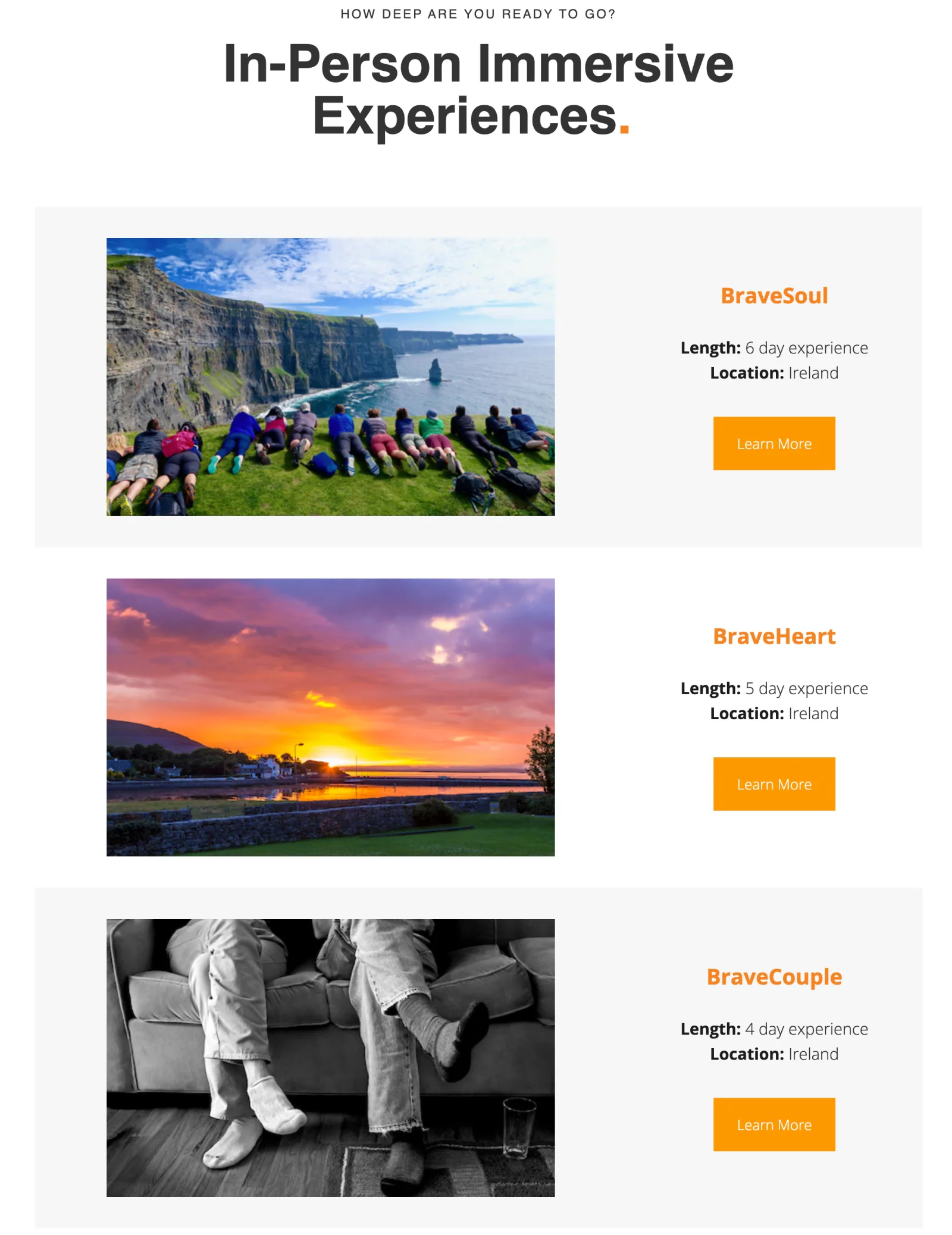
Philip McKernan, an author, coach, and speaker, names his retreats BraveSoul, BraveHeart, and BraveCouple. Image via Philip McKernan.
4. Plan the retreat agenda and schedule
A clear plan of how time will be spent at the retreat has several benefits. It shows you know what you’re doing, helps potential attendees know if the schedule matches their learning style, and minimizes missed expectations.
Provide enough time for your teaching and exercises
Attendees need time to do the work to ensure they’re in a better spot after your retreat than before it.
To ensure that, plan your retreat based on teaching you can cover in four to six hours (if you opt for a two- or three-day retreat). This gives you plenty of time to cover your material while including different ways for implementation, like exercises, questions, and worksheets.
It also leaves you time to tackle any questions and roadblocks so your guests can be 100% ready to keep crushing it once your event is over.
Ensure attendees can accomplish their goal by the end of the retreat
Remember the goal you chose for your retreat in one of the earlier steps? The satisfaction you promised your attendees?
Optimize your retreat agenda and schedule towards that—and make that goal realistic.
Let’s say your retreat is about reflecting on the year past and setting goals for the year ahead. The aim isn’t to let people go home and set goals there or to have a detailed plan for every week of the year—it’s to have a finished list of meaningful goals by the end of your retreat.
Conclude the retreat with a collective experience
Add a final, full-group, collective experience to your schedule—something that connects the community you’ve built.
For example, you can have every attendee share what changed for them and what they’ve accomplished. It will help each of them get more ideas for how to build on this experience and be a lovely conclusion to their retreat.
5. Set the date in stone and find the retreat’s venue
Next, you need to work on two things: your retreat’s dates and venue. You can’t confirm the date until you’re sure the venue you want is available for those dates.
There are several options when it comes to venue types, from lowest to highest cost:
- Vacation home rental with additional catering (joint rooms)
- Dedicated retreat center with on-site food and gathering spaces (joint rooms)
- Hotel accommodation with hotel restaurant and gathering spaces (separate or joint rooms)
As you consider different venues (and with them, your retreat dates), use this list of things to look out for:
- Dietary needs and restrictions the venue can accommodate for
- Accessibility, including like signage, ramps, and elevators
- Parking capacity and the ease of reaching the venue with other means of transport
- Payment options and requirements, including a deposit payment, paying in installments, etc.
- Contract with the venue, including cancellation policies
Once you have your venue and date, you’re ready for the final few steps.
6. Protect yourself with insurance
This is nobody’s favorite topic, but it has to be said: your clients should sign a contract for your in-person retreat that limits your liability.
It should set 100% clear expectations of what will be delivered in a legal document. The contract should also address intellectual property, force majeure, and more—check this with your attorney.
Get attendee signatures when they sign up for your retreat to avoid an awkward situation at the actual event.
Additionally, confirm with the venue whether they include any liability insurance for their premises. If worst comes to the worst, a lawsuit might ruin your retreat and your entire business.
7. Optimize your retreat’s expenses
The final step to a thriving, profitable retreat is keeping your expenses low. Speakers and the venue are arguably the biggest ones—here’s how to optimize them.
How to optimize speaker costs
Your speaker lineup can be one of the biggest selling points for your retreat—but also a tremendous financial hurdle. Here are a few ideas to lower that hurdle:
Want big-name speakers? Have them present over video. It’s not an ideal option, but it allows your attendees to learn from the best while costing you less than having them teach in person.
Invite attendees to do “open problem” presentations. This way, each of them shares what they’re struggling with, and the group discusses potential fixes, or they present a strategy or a solution they’ve found useful. It’s up to you to curate these topics and guide people through their presentations, but it’s a fantastic chance to learn focused best practices from others on their level.
Don’t forget that you are the expert. If you structure your teaching and the exercises around it well, that can be enough to sell your retreat.
Don’t underestimate the power of your expertise.
How to minimize the venue costs
From the three venue types we mentioned earlier, a vacation home rental is often the best option budget-wise—just don’t forget to consider the costs of several days of food.
A dedicated retreat center is next up, as it provides everything you need in one place, it’s more hands-off than a vacation home rental, and more affordable than a hotel.
The venue is also scary to pay for in advance before you’ve started accepting retreat bookings. That’s why we recommend you don’t.
You can check for venue availability on specific dates and, if possible, make a provisional booking you can cancel without fees or penalties. Open for sales as soon as possible, then confirm and pay for the booking only when you have a clearer sense of the group size.
Retreat marketing strategies to sell out all your future retreats
There’s one more fear we haven’t mentioned earlier:
Will anyone be interested at all?
Now, nothing in business is failproof, but when it comes to selling products, services, and events as a creator, one thing comes pretty close: creating a newsletter. It warms your audience to your teaching style, it builds trust, and it helps position you as an expert.
And there’s nothing like a warm audience to excitedly learn they can learn from you in person.
That’s the foundation; here’s how to promote, launch, and sell out your retreat to that audience.
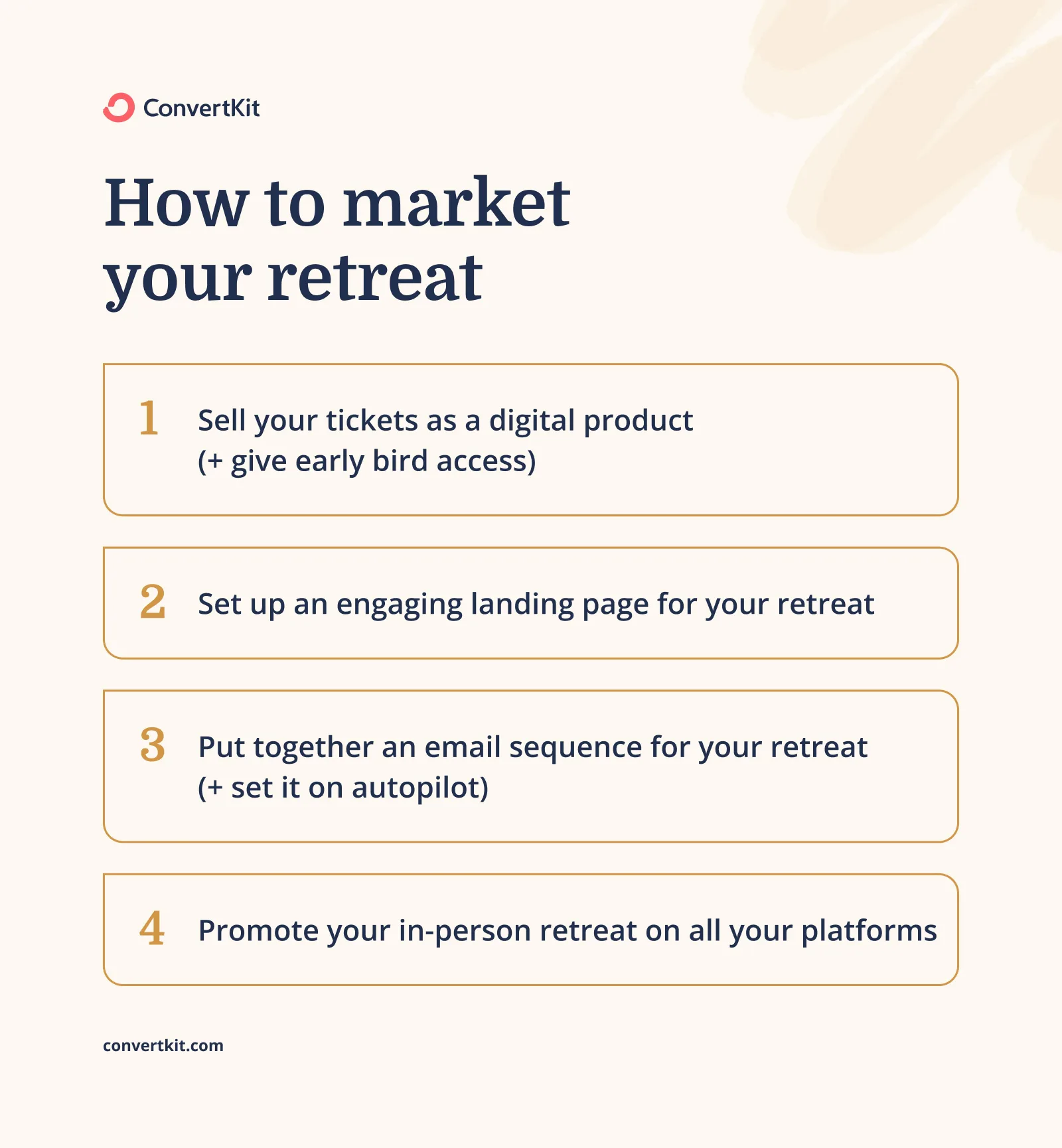
Sell your tickets as a digital product (+ give early bird access)
The best news about launching a retreat? You don’t need a fancy ticketing platform or a robust solution. Jump into Kit Commerce to set up your sales page in minutes.
Step 1: Log into your account, click Earn > Products, then the + New product button. Follow the prompts to add the product name, price, fulfillment type, and the page URL.
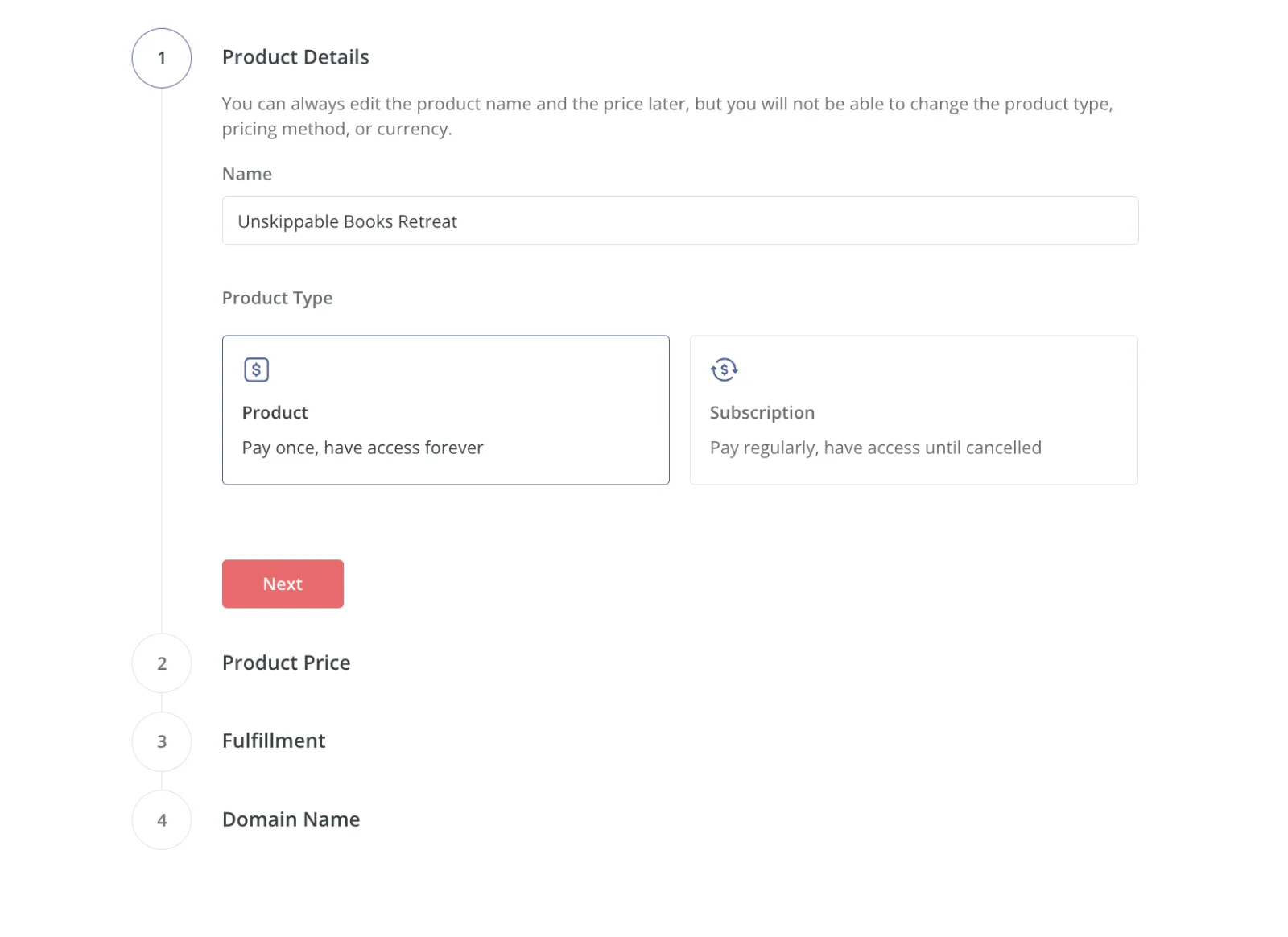
Initial product setup in Kit.
Step 2: Customize your sales page. Write your title, copy, and call-to-action button, add an image, and tweak fonts and colors to match your brand. You can also tweak the checkout and confirmation pages, as well as the receipt email.
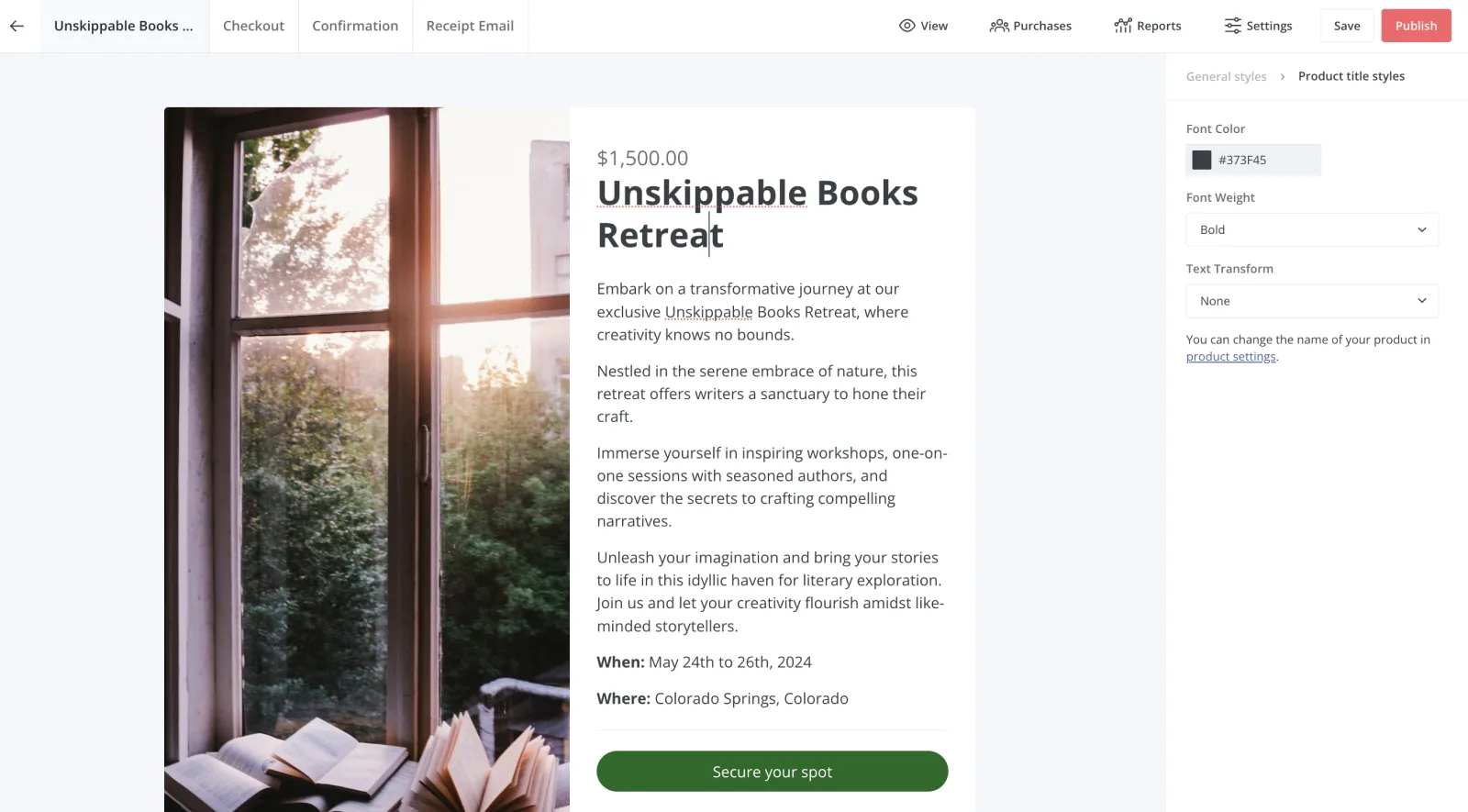
Product page customization in Kit.
Step 3: Publish your retreat sales page by clicking the Publish button at the top right, which will give you the link you can immediately share with your audience.
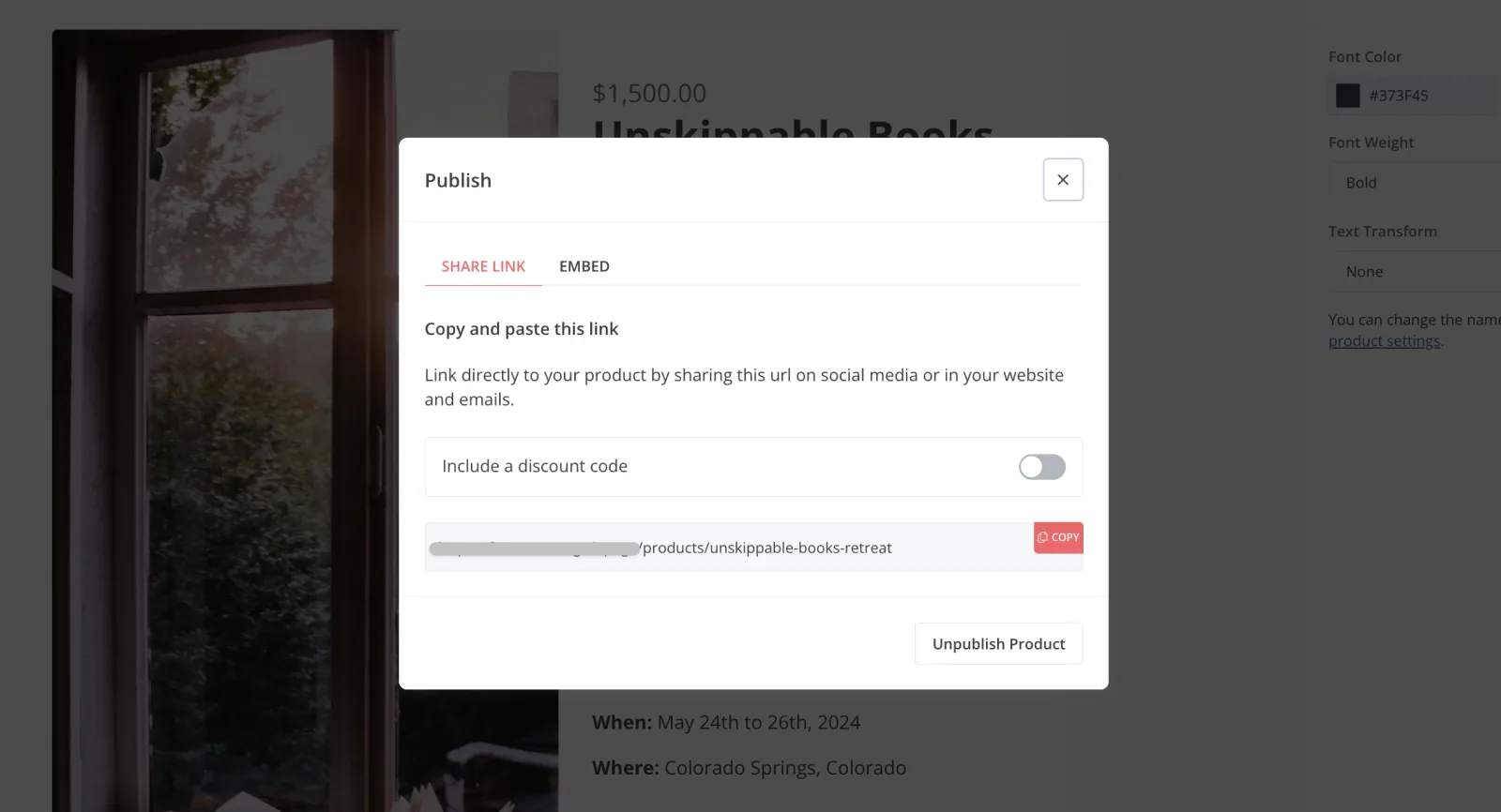
Published product page URL in Kit.
Step 4 (optional): Consider offering an early bird discount to reward early purchases and reward their trust. This is also easy to do right within your product page in Kit. Click Settings at the top of the page, then Discounts, and set up a discount code you can promote in those early launch days.
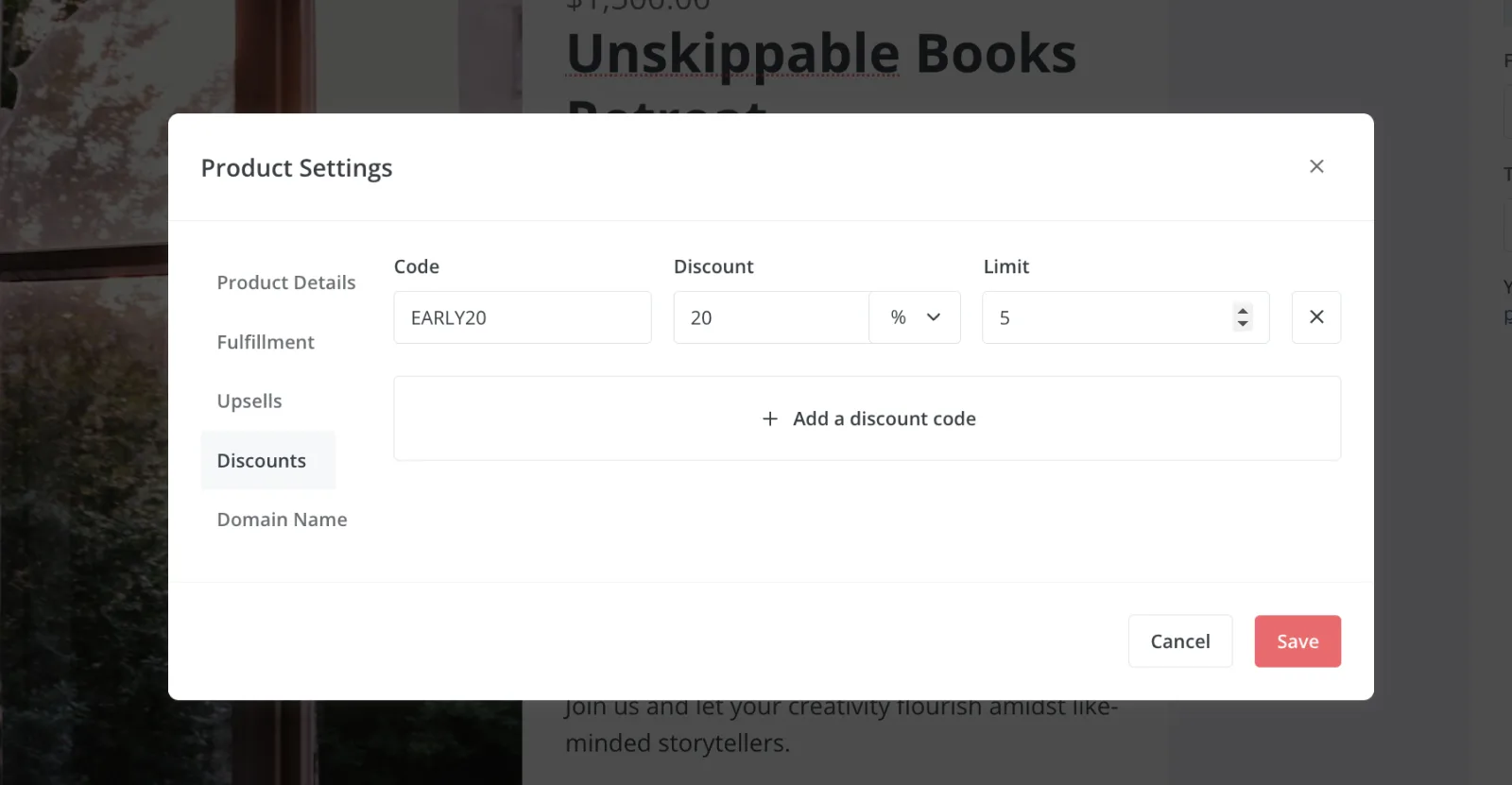
Discount settings for a product in Kit.
Set up an engaging landing page for your retreat
Before you launch a retreat sales page, create a landing page that promotes your upcoming retreat, builds hype, and generates a waitlist for you to launch as soon as you confirm your dates and location.
On it, include these elements:
- Header and subheader: A clear, eye-catching indicator of what the landing page is about.
- Description: Cover what the retreat will include and combine plain text paragraphs with bullet points.
- Pricing: State what’s included in the price and mention payment plans if you offer them.
- CTA: Make what’s on the other end obvious. For example, “Join the waitlist for a 20% early bird discount.”
- Miscellaneous: Add details like social proof from prior attendees or customers, a money-back guarantee, terms and conditions, and a countdown timer until the launch.
Don’t forget about your landing page SEO to reach as many potential attendees as possible leading up to your retreat launch.
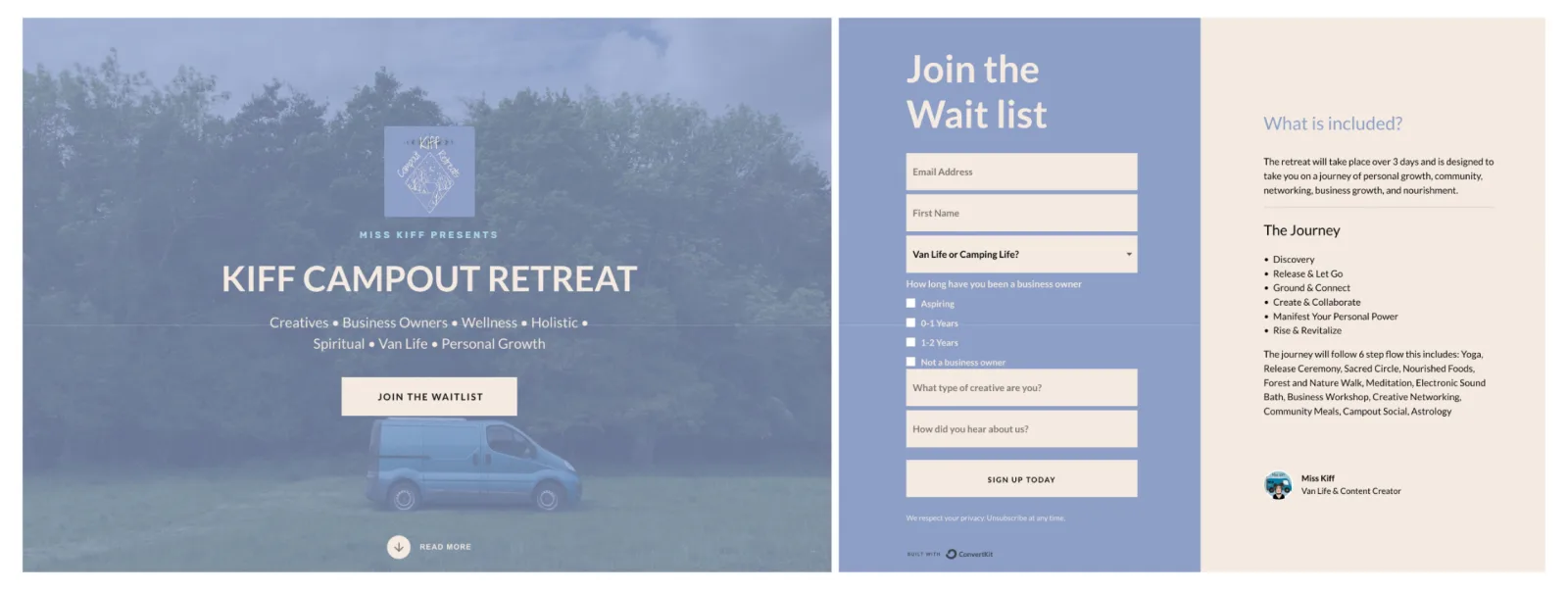
The top and bottom of the Kiff Campout Retreat waitlist landing page. Image via Miss Kiff.
Put together an email campaign for your retreat (+ set it on autopilot)
We emphasize the importance of building an email list long before launching your retreat because it ultimately lets you use email automation workflows to streamline a lot of the work around retreat promotion and communication.
Instead of manually sending each email, you can write them in a burst and schedule them to go out on certain dates based on specific actions (for example, after someone signs up through a retreat landing page).
There are three types of emails you’ll want to write and schedule:
- Retreat invitation emails: Announce the doors are open to purchase a ticket to your retreat. Include details like social proof for your previous work, countdown timers, FAQs, and the end result attendees can expect.
- Retreat confirmation emails: Assure registrants their payment is through and their place in your retreat is secured. Share a travel/prep checklist with them, remind them of the retreat’s goals, and build excitement.
- Retreat follow-up emails: These emails are your chance to thank your attendees, gather feedback, and invite them to share their experiences with friends.
For more details on what to include in each email, how many emails to send, and on what schedule, check out our email marketing guide for all types of events.
You can build each of the three sequences in Kit by going to Send > Sequences. Once you do, you can go to Automate > Visual Automations and tie each sequence to a condition: landing page sign ups to the invitation sequence, purchases to the confirmation emails, and event end date to the follow-up emails.

Sequence editor in Kit.
Promote your in-person retreat on all your platforms
Only a few percent of your social media followers see your posts, so don’t miss any opportunity to share your retreat—its landing page and sales page—with your audience. Some great spots include:
- Newsletter and email list: Regularly mention your retreat in your newsletter, like in a footer or a small embedded section. Adding it to your welcome emails for new subscribers is also a good idea.
- Website: Your website visitors are curious about what you have to offer. Use elements like pop-ups, notifications bars, call-to-actions in blog posts, or your top of the page menu to mention your retreat.
- Social media channels and groups: Tap into Facebook groups, subreddits, Slack communities, and other places your target audience hangs out. Make sure to follow the channel’s or group’s promotion rules.
- Consider newsletter ads: Borrowing an audience another creator has already built is a mighty strategy. Consider the Creator Network or paying for a spot in a newsletter that serves an audience similar to yours.
- Local event platforms: Consider listing your retreat on an event discovery platform for your area. This might be free or low-cost to do and grow your retreat’s visibility.
Take your creative business to new heights with a retreat
Are there ideas for your retreat running around your creative brain? It can take your business, income, and joy of serving your audience to the next level.
All you need is a retreat planning checklist, a retreat marketing strategy, and a platform like Kit to bring every piece of communication together.
Grab your Kit account and start selling today.





